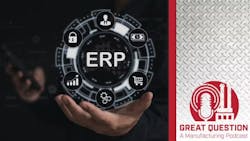Podcast: Manufacturing, AI, and how companies are utilizing disruptive technologies
Stu Johnson is vice president of product marketing at Rootstock Software. With over 35 years of experience in the manufacturing sector, Stu has held various leadership roles and worked with global companies across a range of industries. He began his career as a mechanical engineer and now serves as a leading expert on enterprise solutions for manufacturers.
See also: With AI, the time is now, say manufacturing technologists, futurist, 'evangelist'
Stu recently spoke with Robert Brooks, editor in chief of America Machinist, a sister brand to Smart Industry, about the results of Rootstock Software’s 2024 State of Manufacturing Technology Survey and the industry’s adoption of emerging technologies like artificial intelligence.
Below is an excerpt from the podcast:
American Machinist: You've already described the research report that you've just released. This is the 2024 State of Manufacturing Technology survey, and it seems that, from the respondent’s point of view, AI has moved into the center of their understanding of this discussion. Maybe you disagree with that, but could you give us an executive summary of the report?
Stu Johnson: Surely. And it's actually a pretty robust report. So, I encourage everybody to go get it. I'll only be able to summarize it in the limited time we have here.
See also: Survey: 90% of manufacturers are using AI, but many feel they lag behind competitors
AM: I’ll interrupt and say that they can download it from the Rootstock website. It's available there, so they should do that. Sorry to interrupt you.
SJ: Absolutely. No, thank you for that. But you nailed it. The interesting thing, very interesting for me, I've been kind of keeping AI, giving it the Heisman for the last decade as not being ready for prime time. And in many use cases, it probably still isn't or wasn't, but this generative AI brought it to the fore. So, when you say AI, not everybody understands it. We'll talk about that in one of the other findings we had. But the first key finding that we identified across this thing was around, so the first one is ‘what would you do if you don't digitally transform?’ That was kind of the premise of the report. You have to digitally transform. What if you don't?
See also: How one manufacturer made all its digitized data easily searchable. Hint: It was AI
And it's fairly consistent with last year. Lack of supply chain visibility, 27% said that is one of their biggest concerns. 26% said lack of adaptability to disruptions because disruptions are going to be table stakes, right? About every 3 1/2 years, we should expect a disruption of a month is kind of what McKinsey is saying. But 26% said they're really worried about the ability to get products to market fast enough. And so, you know, that's the kind of thing you'd expect from manufacturers.
The second key finding was "what's driving tech investments?" And just to that point, 41% said operational performance is the number one thing, right? If you're a manufacturer, you buy raw materials, you ship finished goods. The more finished goods you ship in the same amount of time, the more profitable you are. So obviously, that should be driving the business.
But the second thing, and this carried over from last year, I think it was first thing last year, was cybersecurity. Imagine all this data, all this digital transformation, all these signals coming in. You better be worrying about cybersecurity and make sure you have a robust approach to that. And then, not surprisingly, across that ‘what's driving investments?’ is reducing operational costs. If any business is not looking at reducing operational costs and product costs, you're not doing your profitability any good.
Finally, the biggest takeaway, I think, is that over 51% of those surveyed are planning to increase their spending. Maybe that's where they're going to get cost savings so they can spend more on IT to grow faster. But I really found that interesting. That's a pretty big shift in manufacturers to increase spending by that much.
See also: Manufacturing is No. 1 in cyberattacks for third straight year. What can be done?
AM: Yeah, that is a big shift. They don't like to spend, and they have trouble finding the money to spend. So, what has changed? I mean, what has changed about their perception, their outlook, on this subject? Can you identify that?
SJ: Yeah. In fact, that was the first question I asked when the data came out. “Can somebody compare this to last year and tell me what the big differences were?” By and large, everybody was feeling strapped for time and resources more than last year. And there's all kinds of reasons for that because we haven't had any big disruptions. There hasn't been anything to point to why that. But last year, the two biggest things were lack of cross departmental collaboration and limited access to data. That goes back to the data silos, right? How do we get that? And I don't even know that some of those silos exist, even if I could get access to it.
See also: Smart Industry to debut new technology series
But I was fascinated by the lack of collaboration because that's always been a problem. Collaboration is one of the biggest challenges as we grow and as we get even more distributed. But this year, the shift moved towards budgets and time. 31% said that they're more budget constrained than they were last year, and 27% said time. So, you know, time and money. Those are the big obstacles to moving forward
About the Podcast
Great Question: A Manufacturing Podcast offers news and information for the people who make, store, and move things and those who manage and maintain the facilities where that work gets done. Manufacturers from chemical producers to automakers to machine shops can listen for critical insights into the technologies, economic conditions, and best practices that can influence how to best run facilities to reach operational excellence.
About the Author
Scott Achelpohl
Head of Content
I've come to Smart Industry after stints in business-to-business journalism covering U.S. trucking and transportation for FleetOwner, a sister website and magazine of SI’s at Endeavor Business Media, and branches of the U.S. military for Navy League of the United States. I'm a graduate of the University of Kansas and the William Allen White School of Journalism with many years of media experience inside and outside B2B journalism. I'm a wordsmith by nature, and I edit Smart Industry and report and write all kinds of news and interactive media on the digital transformation of manufacturing.

